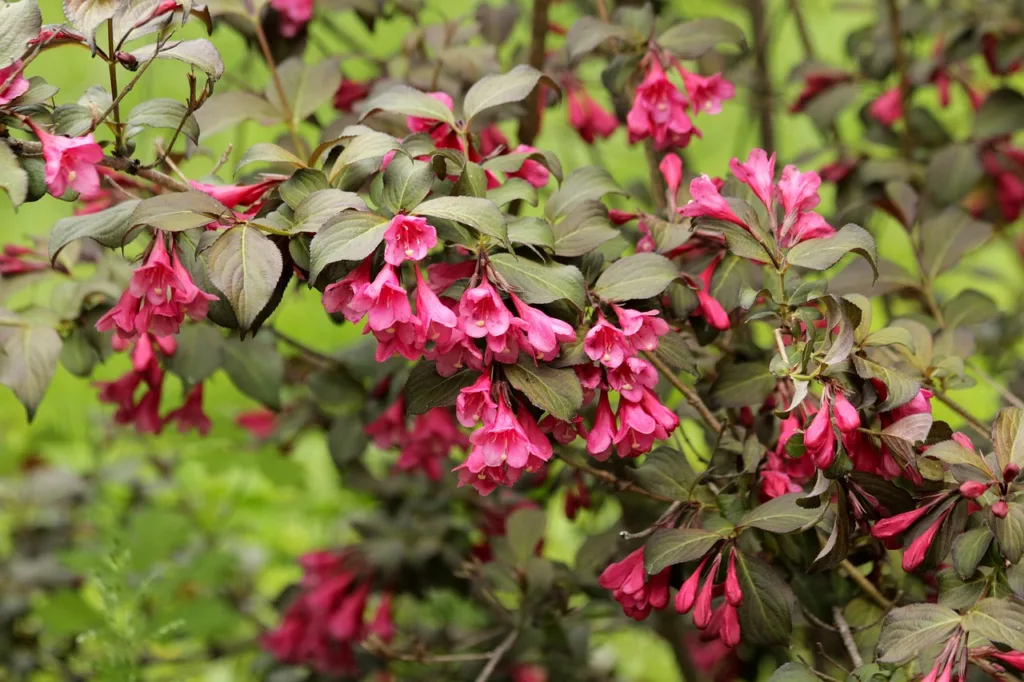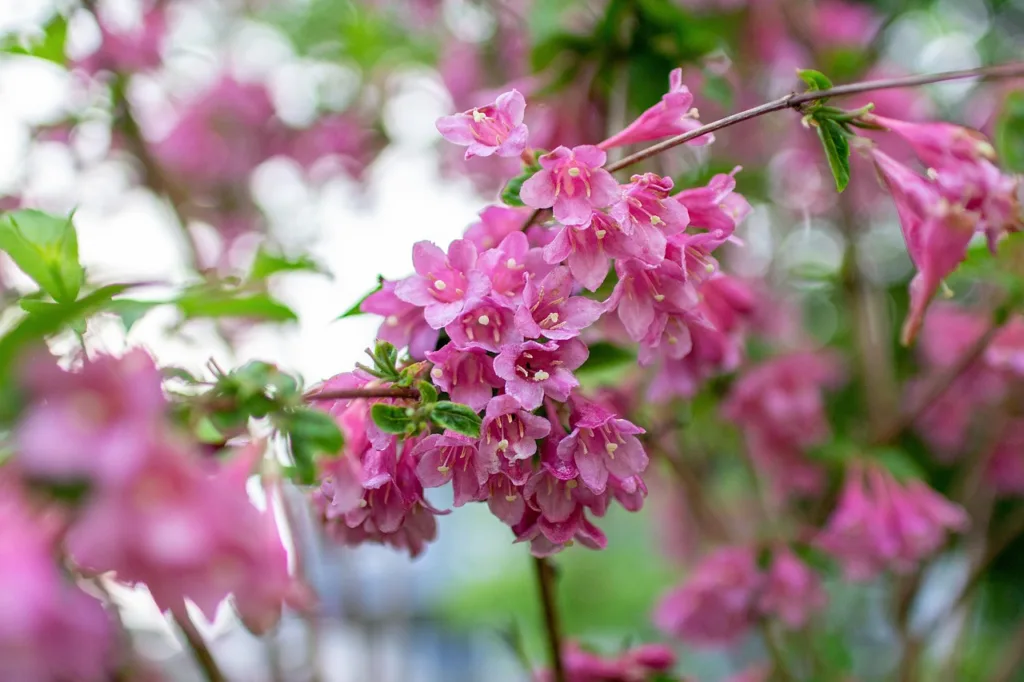Weigela is a genus of deciduous shrubs belonging to the family Caprifoliaceae. These ornamental shrubs are known for their showy, trumpet-shaped flowers and attractive leaves.
Native to Asia, especially China, Korea, and Japan, Weigela species and varieties are widely cultivated in gardens and landscapes for their ornamental value.
Weigela, with its vibrant blooms and graceful habit, is a popular choice among gardeners looking to add a splash of color to their landscape.
This versatile shrub offers an array of flower colors, from deep reds and pinks to soft whites, and can bloom in a variety of growing conditions.
Whether you’re a novice gardener or a seasoned horticulturist, this comprehensive guide will provide you with all the information you need to successfully grow and care for weigela in your garden.
Certainly! Here’s a scientific overview of Weigela presented in a table format:
| Aspect | Description |
|---|---|
| Scientific Name | Weigela |
| Family | Caprifoliaceae |
| Genus | Weigela |
| Native Region | Asia (China, Korea, Japan) |
| Common Species | Weigela florida (most commonly cultivated) |
| Plant Type | Deciduous Shrub |
| Growing Habit | Rounded, spreading growth habit |
| Leaves | Ovate to elliptical, green or variegated |
| Flowers | Tubular, funnel-shaped, in clusters, various colors |
| Blooming Season | Late spring to early summer |
| Sunlight Requirements | Full sun to partial shade |
| Soil Preferences | Well-draining soil, adaptable to various soil types |
| pH Preferences | Slightly acidic to neutral |
| Hardiness Zones | Varies by species and cultivar |
| Pruning | Beneficial for maintaining shape and encouraging blooms |
| Watering | Regular watering, especially during dry periods |
| Uses | Ornamental landscaping, shrub borders, mixed borders |
| Cultivars | Numerous cultivars available with varied flower colors and foliage characteristics |

Choosing the Right Varieties of Weigela
Before diving into the details of cultivation and care, it’s important to choose the right weigela variety for your garden.
Weigela comes in a range of cultivars, each differing in flower color, size, and growth habit. Here are a few popular varieties to consider:
Weigela florida ‘Bristol Ruby’: This variety boasts deep ruby-red flowers and has a compact, rounded habit, making it ideal for smaller gardens or containers.
Weigela florida ‘Variegata’: With its green leaves edged in creamy yellow and delicate pink blossoms, this variety adds a touch of elegance to any landscape.
Weigela florida ‘Carnaval’: A showstopper, ‘Carnaval’ features trumpet-shaped flowers in shades of pink, white, and dark red, all on the same plant.
Once you’ve chosen the variety that appeals to you, it’s time to get your hands dirty and start cultivating your weigela.
Cultivation
Location and Soil
Weigela blooms in full sun to partial shade, so choose a location in your garden that receives at least six hours of direct sunlight each day.
While it can tolerate a wide range of soil types, weigela prefers moist, well-draining soil. Before planting, prepare the soil by mixing in organic matter such as compost or well-rotted manure to improve drainage and enrich the soil with nutrients.
Planting
Early spring or fall is the best time to plant weigela. To ensure a successful establishment, follow these steps:
- Dig a hole that is twice as wide and as deep as the root ball of the weigela plant.
- Gently loosen the roots of the plant and place them in the hole, making sure the top of the root ball is level with the soil surface.
- Backfill the hole with soil, firming it gently around the roots.
- Water the newly planted weigela thoroughly to settle the soil and eliminate any air pockets.
Watering
Proper watering is crucial for the healthy growth of weigela. While weigela is relatively drought-tolerant once established, regular watering is essential during the initial growth period.
Water deeply and thoroughly, making sure the soil is moist but not waterlogged. Avoid overwatering, as this can lead to root rot.
Mulching around the base of the plant will help conserve soil moisture and suppress weed growth.
Pruning
Pruning is an important aspect of weigela care, as it helps maintain the plant’s shape, promotes flowering, and removes dead or diseased wood. Here are some pruning tips:
Annual Pruning: Prune weigela immediately after flowering, usually in late spring or early summer. Remove spent flowers and prune back any overgrown branches to shape the shrub. Avoid excessive pruning, as this can reduce next year’s flower production.
Renewal Pruning: Every three to five years, consider rejuvenating an older or neglected weigela shrub through renewal pruning.
In late winter or early spring, remove one-third of the oldest, woodiest stems at ground level, encouraging the growth of new, vigorous shoots.

Common Pests and Diseases
Like many plants, weigela can be susceptible to certain pests and diseases. By taking a proactive approach and practicing good garden hygiene, you can minimize the chances of encountering these issues.
Pests
Aphids: These small, sap-sucking insects can cause leaf distortion and leave behind a sticky residue. Use insecticidal soap or a strong jet of water to control aphid populations.
Spider Mites: These tiny pests can cause yellowing leaves and fine webbing. Regularly misting the foliage and using insecticidal soap can help keep spider mites at bay.
Diseases
Powdery Mildew: This fungal disease appears as a white powdery coating on the leaves. Adequate spacing between plants, proper air circulation, and avoiding overhead watering can prevent powdery mildew.
Leaf Spot: Leaf spot diseases manifest as small, dark spots on the leaves. Remove and destroy infected leaves to prevent the spread of the disease.
Takeaway Message
Growing and caring for Weigela can be a rewarding experience for any gardener. By selecting the right variety, providing optimal growing conditions, and practicing regular maintenance, you can enjoy the beauty of Weigela in your garden year after year.
From planting and watering to pruning and pest control, following these guidelines will ensure your weigela thrives and becomes a standout feature in your landscape.
So, why not add this stunning shrub to your garden and let its vibrant blooms create a spectacle you can enjoy for seasons to come?
Now it’s time to roll up your sleeves, grab a shovel, and embark on your journey of growing and caring for Weigela. Happy gardening!
People Also Ask
Where does a Weigela grow best?
Optimal Growing Conditions for Weigela:
- Sunlight: Thrives in full sun to partial shade. Best flowering occurs in full sunlight.
- Soil: Well-draining soil is preferred. Weigela is adaptable to various soil types but prefers slightly acidic to neutral pH.
Are Weigela fast-growing?
Weigela Growth Rate:
- Weigela shrubs are considered moderately fast-growing. They can establish themselves well and put on noticeable growth in favorable conditions.
What is the use of the Weigela plant?
Utilizations of Weigela:
- Ornamental: Primarily grown for ornamental purposes in gardens and landscapes.
- Landscaping: Used in shrub borders, foundation plantings, and mixed borders.
- Floral Display: Valued for its showy, trumpet-shaped flowers that attract pollinators.
- Aesthetic Appeal: The plant’s rounded and spreading growth habit adds visual interest, even when not in bloom.
- Variety: Numerous cultivars offer a range of flower colors, sizes, and foliage characteristics, providing diverse options for landscaping.

